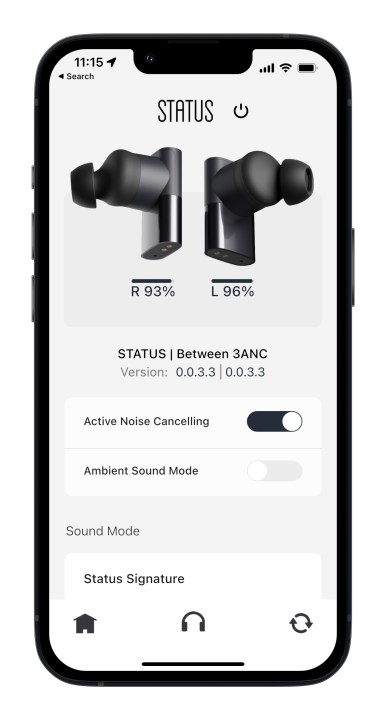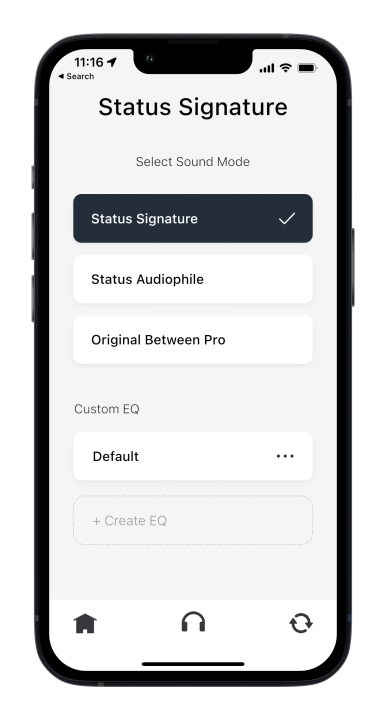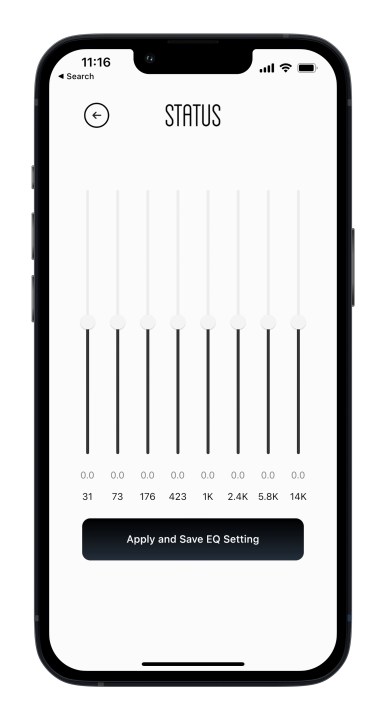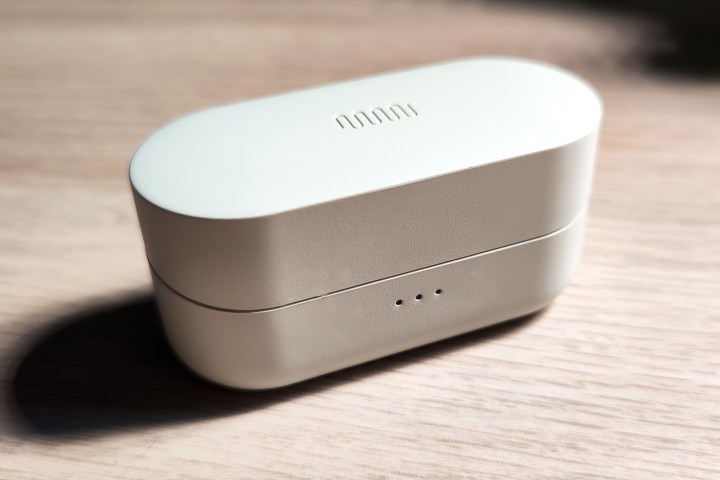
- Super comfortable
- Unique design
- Great battery life
- Amazing call quality
- Powerful sound
- Slightly harsh high frequencies
- No wear sensors
- No hi-res Bluetooth codecs
The very best wireless earbuds typically cost between $200 to $400, with $249 (coincidentally the price of the Apple AirPods Pro 2) being the sweet spot. This is where you find earbuds that have all the most in-demand features and great sound quality. You likely know the names. We’re talking Sony, Sennheiser, Apple, Technics, and JBL.
It is not, however, a price where you’ll usually find relatively unknown brands with short track records attempting to go head-to-head with these household names. But don’t tell Status Audio that. The small, under-the-radar, New York City-based company has been building impressive yet affordable headphones and earbuds since 2014. It recently launched the Between 3ANC — a set of buds that uses the same triple-driver setup as the brand’s popular Between Pro wireless earbuds. But as the name suggests, it adds active noise cancellation (ANC).
While the Between Pro — at $169 — were definitely in line with Status Audio’s more-for-less approach, the Between 3 ANC cost $249, and that price raises the bar on expectations when you consider the competition. Do they deliver? Let’s check them out.

You’ve got to give Status Audio credit for its aesthetic approach to the Between 3ANC. It’s not easy to come up with a wireless earbud design that simultaneously makes a statement, offers a comfortable and secure fit, and avoids the generic stem-based shape of the AirPods, yet these buds do all three.
They are chunky and stick out from your ears, which could interfere with hats or cause a tangle hazard for folks with long hair, so you might want to keep that in mind. But I find the rectangular shape with its polished squares of chrome both eye-catching and minimalist, whether in their Bone guise (pictured) or darker Onyx.

Part of the reason that they stick out so far is that Status Audio has effectively built them as two joined modules. One portion sits in your ear and includes the two balanced armature (BA) drivers. A second, larger portion holds the battery, dynamic driver, and all of the other ingredients.
It may not make for the smallest buds, but it absolutely delivers comfort with a secure fit. Every part that comes in contact with your ear is wrapped in silicone. You get three sizes of eartips and three sizes of “fitwings” — the gasket-like sleeves that wrap the circular portion of the earbuds. With a medium fitwing and the large eartips, I was able to get a really comfortable — and rock-solid — fit. With a claimed IPX5 level of water protection, they should also be able to handle your runs or workouts if you take care to wipe them down afterward.

Controls on the Between 3ANC are also split into two portions: a single physical button sits on top and is used to control ANC, voice assistant access, and a battery life check, while the outer surface acts as a touch control for playback, volume, and call management.
It’s a good system — I found the division of functions intuitive — but the top button proved tricky to use. It’s almost flush to the top of the earbud and is very small, making it difficult to click. A single click (ANC/transparency mode switching) is a little awkward, but the double-click (voice assistant) and triple-click (battery) gestures proved to be quite frustrating because they must be done in rapid succession, otherwise, they can be mistaken for single-clicks.
Unfortunately, there’s no option in the Between 3ANC app (iOS or Android) to customize any of the controls or gestures, so you’ll just have to get used to them as they are, which I eventually did. Speaking of the app, it can also be a bit awkward. Every time you open it, you’ll need to go through a two-step reconnection process to access the earbuds’ status and settings.
Status Audio also chose not to give these earbuds wear sensors — a feature that is nearly ubiquitous at this price — so there’s no auto-pause or resume when removing/reinserting the earbuds.

The earbuds are easy to get in and out of their charging case — which can be charged wirelessly or via the included USB-C cable. The case itself is compact and reasonably pocketable — in size and shape it’s nearly identical to the Sony WF-1000XM4 — and solidly built, with a hinge that is unusually robust.
Wireless connectivity is excellent, with Bluetooth 5.2 support plus Bluetooth Multipoint for two simultaneous device connections, which worked seamlessly when I switched between devices. However, unlike most earbuds in this price range, (except for the AirPods Pro) the Between 3ANC don’t offer any high-quality Bluetooth codecs — only SBC and AAC.
Strangely, this is actually a step down from the Between Pro, which had Qualcomm aptX support. Status Audio claims that codecs like LDAC and aptX Adaptive aren’t as important for earbud sound quality as the drivers, amplification, and tuning and I totally agree. However, if you’ve nailed those other ingredients as Status Audio claims to have done, a high-quality codec can let you get the most out of your hardware.
Still, advanced codecs or not, the Between 3ANC sound great. They have solid full-frequency reproduction. The low end has a resonant quality that reminds me a lot of the WF-1000XM4 — it shows up with a presence you can feel, but only when called upon to do so. Transients are handled with precision — drum hits are snappy and rapid-fire bass line licks (think Flea’s handiwork on the Red Hot Chili Peppers’ cover of Higher Ground) can be appreciated in all of their detail. One of the benefits of Status Audio’s triple driver system is that there’s little in the way of muddying between frequencies. On tracks where deep bass coexists with upper mids and highs — Billie Eilish’s Bad Guy being a perfect example — those elements are effortlessly overlaid, letting you hear each element clearly.
If there’s one area that needs improvement, it’s a tendency for the factory tuning to drive the high frequencies a little too hard. On the one hand, this gives podcasts and other spoken word content extra energy and intelligibility, but on the other hand, it creates noticeable sibilance and harshness. If it bothers you, you can use the companion app to dial things back. This process takes some patience. Unlike the multiband equalizers in other apps, you can’t hear your adjustments in real-time as you move the sliders — you need to hit the apply changes button each time — which is a bit annoying. Thankfully, once you arrive at a mix you like, you can save your formula for next time.
As much as I enjoyed listening to the Between 3ANC, I still prefer the sound of its closest competitors, the $249 Technics EAH-AZ60M2 (which sounds almost identical to the EAH-AZ60) and the $249 Sennheiser Momentum True Wireless 3.

Noise cancellation on the Between 3ANC is also very good — better than the Momentum True Wireless 3, and roughly on par with the Jabra Elite 7 Pro. It’s especially good at creating a hush in busy environments like restaurants, offices, or urban streets, where a variety of frequencies need to be suppressed. It’s a little less effective when dealing with a single droning sound like a noisy fan or a vacuum. Still, given that this is Status Audio’s first set of ANC earbuds, the results are impressive.
Transparency mode is also very capable, but the balance of amplification is a little aggressive — it introduces a bit of background noise that isn’t there when you remove the buds. But if you’re trying to hear the world around you or have a conversation, it’s more than ready for those tasks — just don’t expect an Apple AirPods Pro 2 level of performance, despite the matching price.

Call quality is amazing. The environmental noise canceling on the six microphones is so strong, it almost totally erases background sounds — even fairly loud ones. The one downside is that the system sometimes has trouble distinguishing between those unwanted sounds and your voice. This means there may be times when your caller can’t quite hear you, but because they can’t hear those other sounds either, they may think your cell connection is at fault.
Honestly, this is only going to be an issue on the rare occasion when a dump truck passes by. The rest of the time, whether indoors or outside, the Between 3ANC give your voice an almost studio-like reproduction. Plus, you can activate the transparency mode during a call if you want to hear your own voice more clearly.
Another advantage to the Between 3ANC’s large body that juts out of your ear, is there’s lots of room for a big battery, and Status Audio takes advantage of it. They offer eight hours of playtime and that’s with ANC on, which handily beats the AirPods Pro 2 (six hours), Jabra Elite 7 Pro (7.5 hours), and Sennheiser Momentum True Wireless 3 (6.5 hours). In fact, the Between 3ANC are neck and neck with the Sony WF-1000XM4, on ANC and non-ANC longevity (8 and 12 hours respectively) plus charging case capacity (two full charges), giving the Betweens 24 or 36 hours of total play time.
Normally, this is where I issue a caveat and say that these times are based on 50% volume levels, which you will likely want to exceed. But I found that 50% volume was all I needed, especially with ANC turned on.
It’s hard not to be impressed by what Status Audio has accomplished with the Between 3ANC. At $249, they can’t avoid comparisons to the biggest and best brands in the business, and yet, for the most part, they come away from that comparison very favorably.
Their design, while supremely comfortable and secure, won’t be for everyone, and I think they stop just shy of offering the kind of sound quality I’ve gotten used to from Sennheiser, Technics, and Sony. There are also a few missing extras like wear sensors and advanced codecs and the app could use some tweaks to make it more user-friendly.
Still, with capable ANC and transparency modes, awesome call quality, and top-flight battery life, the Between 3ANC are absolutely worth considering as you make your next wireless earbuds choice.
Editors' Recommendations
- Nothing’s new earbuds upstage Apple, Google, and Amazon by embedding ChatGPT
- Audio-Technica’s latest hi-res earbuds debut at CES 2024 for $199
- JBL’s $200 Live 3 earbuds get the Tour Pro 2’s touchscreen charging case
- 1More’s PistonBuds Pro Q30 look like great budget buds at $50
- JLab jumps into hi-res and Bluetooth LE audio with $200 Epic Lab Edition earbuds










